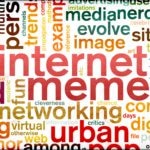The science of memetics – and how it can launch your next big work project
Whether it was an image of a dog, a grumpy cat, a disguised hyperlink to Rick Astley, or an illustrated stickman called Bill, you’ve probably seen – and maybe even shared – a meme in the past 24 hours.

While their intent is primarily to make people laugh, memes received during work hours can be something of a distraction. But memes are good for more than diversion – applied in the right circumstances, the science behind them can also help us accelerate work’s progress.
Operating within a big organization means lots of stakeholders and complicated approval processes, and getting buy-in for projects or ideas can be a challenge. When there are so many people to please, we often take the easy option and stick to protocol rather than risk rocking the boat with something new that might never happen anyway.
But what if, like The Dress, or Gangnam Style, we could get our project to go viral? What if we could, with very little effort, inspire everybody in our workplace to get involved?
By communicating your idea in a way that lends itself to virality, you make it easier for people to consider what it is you have to say. They will probably copy it, and apply it in their own field, or at least pass on the information to another person, who then tells another person, and so on. Either way, a lot of the effort involved in realizing the idea is alleviated from you and spread across your workplace.
Every big business idea you’ve ever come across is essentially a successful meme. Sustainability. Digital Transformation. Futureproofing… whatever it is you want to launch – wellness initiative, sustainability agenda, research project, or new product – launching will be a lot easier if you can develop an understanding of the science of memetics.

Critical mass
As memes scale from obscurity to virality, they reach a moment known as critical mass. Whether you call it critical mass, boiling point, percolation threshold or tipping point, the meaning is the same: the magic moment at which an idea is diffuse enough to grow and sustain itself long term.
Transport yourself and your smartphone back 20 years – how useful would all your apps have been then? There would be no point having Facebook if nobody else was on Facebook. There would be no point using Slack if nobody else used Slack. But as more people downloaded and used such apps, a critical mass was reached – and your phone became more useful, eventually to the point today where it is an almost ubiquitous part of your life.
Your idea also exists within a network of people, and if you want it to go viral, it must first be achieve a critical mass of users. Generally, the value of your idea increases with the size of your network. The more people that buy in, the greater its impact and visibility. Eventually, the number of advocates for your idea reaches critical mass, and being aware of it becomes a critical competency of people who work in your organization, department, or team. For instance, although email was once mistrusted and considered something of a fad, you’ll struggle to find an office worker today who is not well-versed in its use.
A useful idea tends to lead early adopters to persuade those around them of its virtues. This situation creates a positive feedback loop and, generally, the more a new idea depends on a network of users, the faster it will reach critical mass. In business, ideas spread and evolve via two memetic processes: mimicry and remixing. Mimicry is about recreating or redoing; one team sees another team doing something well, and copies it. Whereas remixing involves combining different contexts and ideas to make one new thing. Like applying design thinking to banking.
Transforming your nascent project or idea into something that surpasses critical mass and goes viral in your organization means inspiring enough people to mimic, remix and share it. To do this, three things must be taken into account:
1. Anatomy
Most successful work memes share a common anatomy. They are:
Flexible – Nobody can be the master of everything. But by being curious about what’s happening outside, and working as if their organization is one big team, workers can benefit from ideas that weren’t initially intended to be applied to their field. Every worker is open to new ideas that could potentially improve their output or make their life easier. You just have to make it relevant: present your project as a flexible concept that, with a little remixing, will have specific benefits for the person you’re selling it to. If you’re talking to somebody in finance about a zero plastic waste initiative, for instance, explain how you have found alternative materials at a lower cost.
Shareable – Stewart Brand’s famous saying that ‘information wants to be free’ is only true because people are naturally gossipy creatures. The act of sharing strengthens our social ties, defines our interests and helps us express ourselves to others. Memes tap into this innate human instinct because they are cultural units ready-made for replication – they are incredibly easy to share. Ideas are shareable when they are easy to understand, memorable and packaged with a story your target audience can relate to. Crafting and perfecting an elevator pitch for your idea will go a long way to achieving this.
Prestigious – Most workers want to be seen as being in on the ‘next big thing’. Help colleagues understand that by getting involved with your idea, they will take on the prestige of being one of its early adopters.
The onus is on you to craft your message in a way that fits this anatomy. Even if you have the best idea in a world, if you can’t communicate it effectively, you’re not going to inspire somebody to share, mimic or remix it.
2. People
The most effective way to prime your ecosystem for critical mass is to build a small network of dedicated specialists devoted to your idea. These specialists are habitual sharers of information, and will help you circulate knowledge organically, through word of mouth.
Connectors, your highly-sociable, curious, energetic and confident colleagues, will help get the word out to their large (typically 100+) personal network.
Mavens meanwhile are the colleagues you rely on to tell you which laptop you should buy, or which restaurant in your area serves the best steak, or how to cope during times of increased stress. They are highly intelligent and, above all, trustworthy. Use them to authenticate your idea: “If Clara is backing it, it must be good.”
And finally, Salesmen: those well-versed in the art of negotiation and psychology, who can sell your idea to skeptics and broker the compromise necessary to achieve lift-off.

3. Timing
Timing is everything. Pushing your idea too early may end in costly mistakes – if the ecosystem is not ready for it, it probably won’t take off. Whereas getting in too late means people have already interacted with your idea or even launched it themselves, and now its novelty value has worn off – other priorities have taken hold.
This is why first priming your idea for virality, and then your ecosystem for critical mass (by building a network of dedicated specialists) is so important. Once these mechanisms are in place, you open up a bigger window for the big launch.
With the slightest push — in just the right place — it can be tipped”
The magic number
You might be thinking, that’s all very well, but how will I know my idea has hit critical mass? At what percentage of a population will I be able to sit back and watch the memetic magic flow?
Researchers at the Rensselaer Polytechnic Institute report that the answer to that question is a mere 10%. Using computational analysis, they were able to establish the point at which critical mass is reached.
“When the number of committed opinion holders is below 10 percent, there is no visible progress in the spread of ideas,” says director of research Boleslaw Szymanski. “It would literally take the amount of time comparable to the age of the universe for this size group to reach the majority. Once that number grows above 10 percent, the idea spreads like flame.”
That’s a tantalizingly low threshold. And, with the advent of advanced workflow management and collaboration software, it is now easier than ever to get your formative ideas, products, messages and behaviors to go viral.
Although the world “may seem like an immovable, implacable place,” writes Malcolm Gladwell in his influential book The Tipping Point, “it isn't.”
*If you’d like to learn more about memetics, life and career opportunities at a company that is leading the way for 21st century banking, please visit BBVA Careers and follow us on LinkedIn.